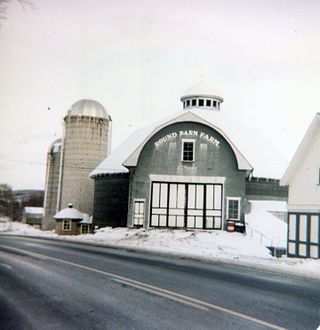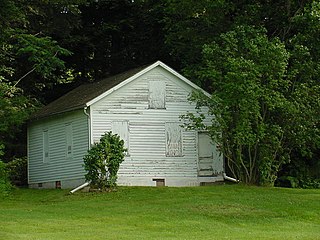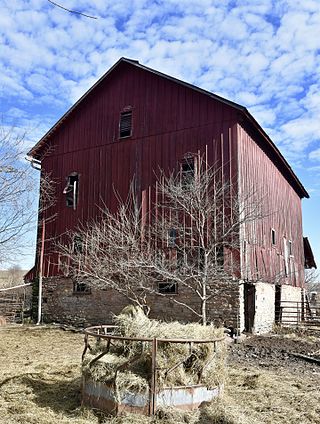
Fox Chase Farm is one of two working farms in the city of Philadelphia, Pennsylvania. Formerly owned by the Wistar family, the farm is located on Pine Road in the Fox Chase neighborhood of Northeast Philadelphia on the border with Montgomery County. The farm gradually became surrounded by the city's residential neighborhoods and was purchased by the city in 1975. It is now run as an educational farm by the School District of Philadelphia.

The Hemingway-Pfeiffer House, also known as the Pfeiffer House and Carriage House, is a historic house museum at 10th and Cherry Streets in Piggott, Arkansas. It is where novelist Ernest Hemingway wrote portions of his 1929 novel A Farewell to Arms. Hemingway was married to Pauline Pfeiffer, the daughter of the owners of the house, Paul and Mary Pfeiffer.

A round barn is a historic barn design that could be octagonal, polygonal, or circular in plan. Though round barns were not as popular as some other barn designs, their unique shape makes them noticeable. The years from 1880 to 1920 represent the height of round barn construction. Round barn construction in the United States can be divided into two overlapping eras. The first, the octagonal era, spanned from 1850 to 1900. The second, the true circular era, spanned from 1889 to 1936. The overlap meant that round barns of both types, polygonal and circular, were built during the latter part of the nineteenth century. Numerous round barns in the United States are listed on the National Register of Historic Places.

The Langworthy House, also known as the Octagon House, is a historic building located in Dubuque, Iowa, United States. Built in 1856, it was designed by local architect John F. Rague for local politician Edward Langworthy. The two-story brick home features tall windows, a columned entry, and a windowed cupola. Langworthy and three of his brothers were among the first settlers in Dubuque. They were partners in a lead mine, helped to build the territorial road between Dubuque and Iowa City, they farmed, invested in real estate, and they owned a steamboat and a mercantile exchange. The house has been passed down through Langworthy's descendants. It was individually listed on the National Register of Historic Places in 1975, and it was included as a contributing property in the Langworthy Historic District in 2004.

The Dr. Hovey Everett House is a Greek Revival style house in the hamlet of Lowman in the town of Chemung, New York. It is significant both for its architecture and for its association with the life of Dr. Hovey Everett, who practised medicine in the area including Lowman and nearby Elmira, New York for forty years, from his arrival in the area in 1821 until his death in 1861. The house was built in 1827 as a wedding present for Dr. Everett upon his marriage to Cynthia Lowman, of the family for whom the town was named. The house and related buildings and structures were added to the National Register of Historic Places in 2007.

The Croul–Palms House is a private residence located at 1394 East Jefferson Avenue in Detroit, Michigan. The house is named after its first two owners, Jerome Croul and Francis Palms. It was listed on the National Register of Historic Places in 1983.

Young–Yentes–Mattern Farm, also known as Maple Grove Farmstead, is a historic home and farm located in Dallas Township, Huntington County, Indiana. The farm includes three residences: the original log house (1838), the former Dallas Township School Number 2 and used as a residence, and the Queen Anne main house built between 1896 and 1910. The two-story, frame main house has a front facing gable roof with fishscale shingles and a wraparound porch. Also on the property are a number of contributing outbuildings including the milk house, chicken house, garage, smokehouse, hog house, small barn, and large bank barn.

Young Round Barn is a historic round barn at Greene in Chenango County, New York built in 1914. It is located on ‘’’Round Barn Farm’’’.
Peter A. Hilton House is a historic home located at Beekman Corners in Schoharie County, New York. It was built about 1799 is a 2+1⁄2-story, five-bay, gable-roofed brick residence in the Federal style. A gable-roofed, 1+1⁄2-story brick kitchen wing projects from the rear. Also on the property is a Dutch barn, horse barn, and pig / sheep barn.

Applewood Farm is a farmstead in Ledyard, Connecticut, United States. Constructed in 1826 by Russel Gallup, the farmhouse was built with a colonial center chimney design with Federal style details that has been modernized to the early 20th century without significantly changing the floor plan. Named after the apple orchards planted by Russel Gallup, Applewood Farm developed significantly under the ownership of Everett Gallup, the last member of the family to own the property. The property was later owned by Arlene Meyer Cohen and a 40-acre parcel was sold off in November 1984. After the Betz family became the owners it was added to the National Register of Historic Places and operated as a bed and breakfast through the 1990s. In 1987, the property included five contributory structures, the farmhouse, corn crib, barn, silo and chicken coop. The property also has one non-contributing structure, a machinery shed from the 1960s.

Everett Historic District is a rural village located within Cuyahoga Valley National Park. It is registered on the National Register of Historic Places. Everett is unique for being uncompromised by the pressures of suburban development. It represents a typical unincorporated hamlet of the turn of the 20th century rural America.

The Persia Beal House is a historic house at 797 Chesham Road in Harrisville, New Hampshire. It is now the Harrisville Inn. Built about 1842, it is one of the best-preserved 19th century connected farmsteads in the town. The property is also notable for its association with Arthur E. Childs, who purchased the property to serve as the estate farm for his nearby Aldworth Manor summer estate. The house was listed on the National Register of Historic Places in 1988.

The Gen. Mason J. Young House, also known as the William Boyd House, is a historic house and connected farm complex at 4 Young Road in Londonderry, New Hampshire. With a building history dating to 1802, it is a well-preserved example of a New England connected farmstead. The house was listed on the National Register of Historic Places in 1986.

The Henry Wishard House, also known as the Fenton House, is a historic residence located in Bloomfield, Iowa, United States. Wishard was a prominent Bloomfield businessman, who was known as the father of the gasoline tax in the United States to raise revenue for road construction. He also built more than 100 buildings in Bloomfield and Dighton, Kansas. Wishard had this two-story brick house built in the Queen Anne style in 1910. The property also included a barn, a chicken house and another small out-building. The barn was replaced with a garage that complements the house, and the other two structures have subsequently been removed. The house was listed on the National Register of Historic Places in 2004.

The Vander Wilt Farmstead Historic District, also known as the Heritage House Bed and Breakfast, is an agricultural historic district located north of Leighton, Iowa, United States. At the time of its nomination it included three contributing buildings, three contributing structures, one non-contributing building, and two non-contributing structures. The significance of the district is attributed to its association with progressive farming and the Country Life Movement, which sought to improve the living conditions of rural residents. The contributing buildings include the 1904 barn, the house (1920), the corn crib (1953), dairy barn (1955) and the feed lots. The two-story house was built by Douwe Sjaardema, a contractor from Pella, Iowa. The corn crib was built by the Iowa Concrete Crib & Silo Co. of Des Moines. The farm also includes a former landing strip for airplanes. It featured a 1,500-foot (460 m) grass runway where cows grazed on certain days. At one time it had a windsock and homemade landing lights. A hangar, no longer in existence, had been built in 1955. An automobile garage and two silos are the non-contributing resources. The district was listed on the National Register of Historic Places in 2004. The 1904 barn has subsequently been torn down.

Top Acres Farm, known historically as the Fletcher–Fullerton Farm, is a farm property at 1390 Fletcher Schoolhouse Road in Woodstock, Vermont. Developed as a farm in the early 19th century, it was in continuous agricultural use by just two families for nearly two centuries. It was listed on the National Register of Historic Places in 2004.

The Pleasant Lawn School Historic District is a nationally recognized historic district located northeast of Mount Pleasant, Iowa, United States. It was listed on the National Register of Historic Places in 1987. At the time of its nomination it consisted of three resources, all of which are contributing buildings. This is the only intact example of a consolidated rural school district in Iowa. It consists of a two-story brick school building (1917), a two-story frame teacherage (1917), and a hack barn. A gymnasium was added to the school building in 1941. The school was still in existence when the buildings were added to the National Register.

Henyon-Kasper-Duffy Barn is a historic building located south of Solon, Iowa, United States. The barn was built for Bradford "Hoss" Henyon in 1876. He owned this farm from 1848 until his death in 1879. He used the barn as a changing station for horses on both the stage route and the mail route on the Old Dubuque Road, which passed in front of the farm. James B. Kasper bought the farm from the Henyon's and his son John took over from him. They also housed horses in the barn. John's son-in-law Charles D Duffy bought the farm from John Kasper, his father in law, and then his son Chuck succeeded him in the operation. Charles Duffy and wife Joyce housed hogs and then began the Newport Valley Shorthorn cattle Charles is well known for.

The Rosine General Store and Barn, also known as Woosley's General Store, is in the small hamlet of Rosine, Kentucky located at 8205 Blue Moon of Kentucky Highway / U.S. Route 62. It was built in 1933 and expanded in 1947. It was listed on the National Register of Historic Places in 2003.






















